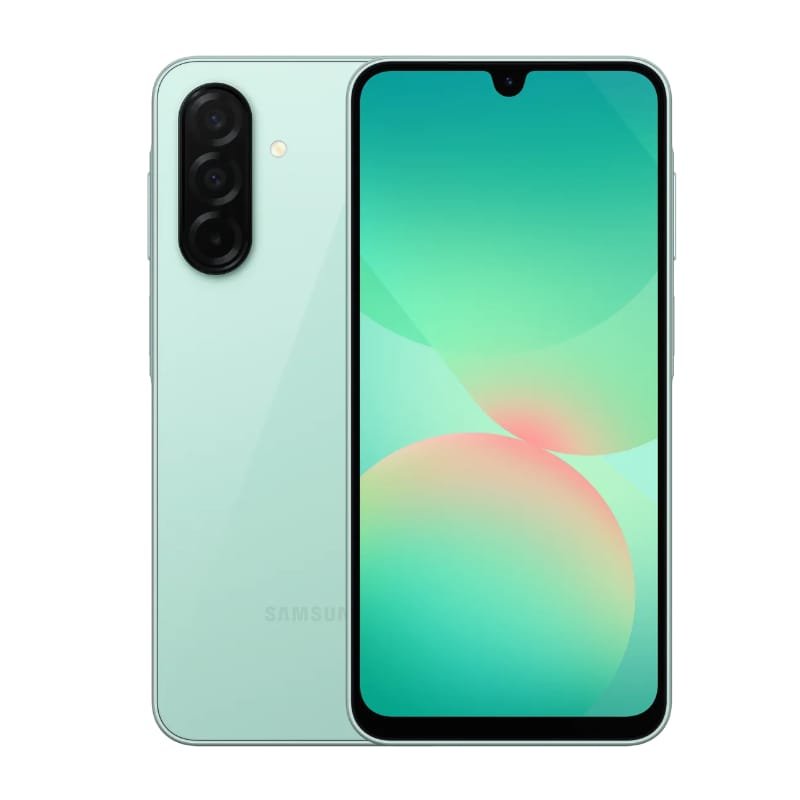Samsung’s Galaxy A-series consistently churns out some of the most popular smartphones in the mid-to-low-range segment, striking a delicate balance between essential features, reliable performance, and an accessible price point. Within this expansive lineup, the A2x series often serves as the entry point for those seeking a modern smartphone experience without breaking the bank. In this detailed comparison, we delve into the Samsung Galaxy A26, the latest iteration, and its predecessor, the Samsung Galaxy A25. We’ll examine every facet, from design and display to performance, cameras, battery life, and overall value, to help you determine which of these budget-friendly devices best suits your needs, with insights from Mobihub Electronics.
1. Design and Build Quality: A Step Towards Premium
While both the Galaxy A26 and A25 adhere to Samsung’s recognizable design language, the newer A26 makes a significant stride in terms of build materials, bringing a touch of the premium feel typically reserved for higher-tier models.
Samsung Galaxy A25: Released in December 2023, the Galaxy A25 features a practical and clean design. It sports a 6.5-inch display with a teardrop notch for the front camera, a slightly dated design choice compared to the punch-hole cutouts on higher-end models. The device has a plastic frame and back, with the front protected by Corning Gorilla Glass 5. It measures 161 x 76.5 x 8.3 mm and weighs 197 grams. A notable omission for the A25 is the lack of an official IP rating for dust and water resistance, which is a significant factor for durability. It comes in various appealing colors like Brave Black, Personality Yellow, Fantasy Blue, and Optimistic Blue.
Samsung Galaxy A26: The Galaxy A26, launched in March 2025, represents a considerable upgrade in build quality. While maintaining a slim and flat design, it now features Corning Gorilla Glass Victus+ on both the front and back, a material typically found on more expensive smartphones. This drastically improves scratch and drop resistance, lending a far more premium feel in hand. The A26 is also slightly thinner at 7.7 mm and weighs 200 grams. A key improvement is the inclusion of an IP67 rating for dust and water resistance, meaning it can be submerged in up to 1 meter of fresh water for 30 minutes. This provides crucial peace of mind against accidental spills and splashes. It comes in new vibrant colors such as Black, White, Mint, and Peach Pink, offering fresh aesthetic choices. The teardrop notch for the front camera persists, however.
Shared Design Elements: Both phones feature a side-mounted fingerprint sensor integrated into the power button, a reliable and fast method for unlocking. They also utilize a USB Type-C 2.0 port for charging and data transfer.
Design and Build Verdict: The Samsung Galaxy A26 is the clear winner in this category. The upgrade to Gorilla Glass Victus+ on both sides and the addition of an IP67 rating significantly enhance its durability and premium feel, making it a more robust and attractive device compared to the A25.
2. Display: A Size Bump with a Brightness Puzzle
Samsung’s Super AMOLED displays are a hallmark of its smartphones, and both the A26 and A25 benefit from this vibrant technology, offering rich colors and deep blacks.
Samsung Galaxy A25: The Galaxy A25 sports a 6.5-inch Super AMOLED display with a Full HD+ resolution (1080 x 2340 pixels) and a pixel density of approximately 396 ppi. It boasts a smooth 120Hz refresh rate, providing fluid scrolling and animations. The display’s typical peak brightness in High Brightness Mode (HBM) is rated at 1000 nits, offering decent visibility outdoors.
Samsung Galaxy A26: The Galaxy A26 features a slightly larger 6.7-inch Super AMOLED display, maintaining the same Full HD+ resolution (1080 x 2340 pixels) and a 120Hz refresh rate. While the increase in size provides a more expansive viewing area, interestingly, some reports indicate that the A26’s peak brightness might be lower than the A25’s, with measurements around 777 nits (peak) or 800 nits (peak) to 1000 nits (HBM) depending on the source, compared to the A25’s 1000 nits (HBM). This is a peculiar downgrade for outdoor legibility. The display is protected by Corning Gorilla Glass Victus+.
Shared Display Features: Both phones offer the inherent benefits of Super AMOLED:
- Vibrant Colors and Deep Blacks: Essential for an immersive multimedia experience.
- 120Hz Refresh Rate: Ensures a silky-smooth user interface.
- Always-On Display: For convenient glanceable information.
- Teardrop Notch: Both retain this design for the front camera.
Display Verdict: While the Galaxy A26 offers a slightly larger screen size, the Galaxy A25 surprisingly holds an edge in typical peak brightness, which is crucial for outdoor visibility. This is an unexpected turn, making the A25 potentially better for use under direct sunlight. However, the A26’s newer Gorilla Glass Victus+ offers better screen protection.
3. Performance: A Meaningful Power Boost
The processing power under the hood dictates the phone’s overall responsiveness, app handling, and gaming capabilities. Here, the A26 brings a clear upgrade (for most regions).
Samsung Galaxy A25: The Galaxy A25 is powered by Samsung’s Exynos 1280 chipset, built on a 5nm fabrication process. This octa-core processor features 2×2.4 GHz Cortex-A78 cores and 6×2.0 GHz Cortex-A55 cores, coupled with a Mali-G68 GPU. This chipset provides adequate performance for daily tasks, social media, web Browse, and casual gaming. Its AnTuTu v10 benchmark score is around 480,771.
Samsung Galaxy A26: The Galaxy A26 features the newer Exynos 1380 chipset, also built on a 5nm process. This octa-core processor boasts a more powerful configuration with 4×2.4 GHz Cortex-A78 cores and 4×2.0 GHz Cortex-A55 cores, paired with a Mali-G68 MP5 GPU (an upgrade from the A25’s Mali-G68). This translates to a notable performance improvement. AnTuTu v10 benchmark scores for the A26 are around 579,811, indicating a significant 20% higher combined performance, with a 30% increase in CPU-heavy workloads and about 20% higher GPU performance compared to the Exynos 1280. Important Note: Some regions, particularly Latin America, might receive the Galaxy A26 with the older Exynos 1280 chipset, negating this performance advantage. It’s crucial to verify the chipset for your specific region before purchasing.
RAM and Storage: Both phones are generally available with 6GB or 8GB of RAM, and 128GB or 256GB of internal storage. Both also feature a microSDXC slot for expandable storage (using a shared SIM slot) up to 1TB or 2TB depending on the specific model, which is excellent for users with large media libraries.
Performance Verdict: For regions receiving the Exynos 1380, the Samsung Galaxy A26 offers a substantial performance upgrade over the A25, making it better suited for more demanding applications, multitasking, and a smoother gaming experience. If you are in a region with the Exynos 1280 A26 variant, the performance difference will be negligible.
4. Camera System: Identical Hardware, Subtle Software Tweaks
Samsung has opted for a consistent camera hardware setup across these two generations, focusing on software optimization for any potential improvements.
Shared Camera Hardware: Both the Galaxy A26 and A25 feature an identical triple-camera setup on the rear:
- 50MP Main Camera: (ƒ/1.8 aperture, PDAF, OIS) – This is the primary shooter, capable of capturing detailed images with optical image stabilization for sharper photos and more stable videos.
- 8MP Ultra-Wide Camera: (ƒ/2.2 aperture, 120˚ field of view) – For expansive landscapes and group shots.
- 2MP Macro Camera: (ƒ/2.4 aperture) – For extreme close-up photography.
Front Camera:
- Both phones feature a 13MP front camera (ƒ/2.2 aperture) housed in the teardrop notch, suitable for selfies and video calls.
Camera Performance and Features: While the hardware is the same, the A26’s newer Exynos 1380 (where available) brings a more powerful image signal processor (ISP) and Neural Processing Unit (NPU). This can lead to subtle but meaningful improvements in:
- Computational Photography: The A26 might offer more refined image processing, better dynamic range, and improved noise reduction, especially in challenging low-light conditions.
- Night Mode: Reviewers suggest the A26 produces cleaner photos with less noise and resolves more detail in shadows during nighttime shots, though the A25 might have better color reproduction at night.
- Video Recording: Both support 4K video recording at 30fps and 1080p at 30/60fps with gyro-EIS for stabilization. The A26 might show slightly better nighttime video clips.
- AI Enhancements: The A26 is positioned to leverage more of Samsung’s “Awesome Intelligence” features, which could include enhanced object erasure, smarter scene optimization, and potentially new filters or editing tools.
Camera Verdict: The camera differences are subtle. The Galaxy A26 offers marginally better computational photography and low-light performance due to its newer chipset, making it slightly superior for overall image quality, especially in challenging conditions. However, the A25’s camera is still very capable for its price point.
5. Battery Life and Charging: Endurance Meets Consistency
Both phones are equipped with substantial batteries, promising reliable all-day power. The charging speed remains consistent between the two.
Shared Battery Capacity: Both the Samsung Galaxy A26 and A25 feature a large 5000 mAh non-removable battery. This capacity is ample for typical daily use, easily lasting a full day for most users, and potentially extending into a second day with lighter usage.
Charging Speed: Both devices support 25W wired fast charging.
- The Galaxy A25 takes approximately 29 minutes to reach 50% and around 83 minutes for a full charge.
- The Galaxy A26 also takes similar times, reaching about 51% in 30 minutes and a full charge in around 86 minutes.
Neither phone supports wireless charging.
Battery Life Performance: In terms of actual battery endurance, tests indicate that the difference between the two phones is negligible. Both offer generally good battery life, though some reviews suggest it can be “subpar” for demanding users who push the phone continuously. The A25 sometimes shows slightly better results in video playback and continuous usage tests, but the differences are marginal.
Battery and Charging Verdict: This category is largely a tie. Both phones offer excellent 5000 mAh batteries and 25W wired fast charging. There’s no significant upgrade in either battery endurance or charging speed from the A25 to the A26.
6. Software and Updates: A Clear Advantage for Longevity
Samsung has made a strong commitment to software support for its A-series, and the A26 benefits significantly from this extended policy.
Samsung Galaxy A25: Launched with Android 14 and One UI 6. Samsung promised 4 generations of Android OS upgrades and 5 years of security updates. This means the A25 is expected to receive updates up to Android 18.
Samsung Galaxy A26: Launched with the latest Android 15 and One UI 7. Samsung has further extended its commitment for the A26, promising an impressive 6 generations of Android OS upgrades and 6 years of security updates. This means the A26 is expected to receive updates all the way to Android 21, making it incredibly future-proof from a software perspective. The One UI 7 also brings general UI refinements, new features, and deeper integration with Samsung’s AI capabilities.
Software and Updates Verdict: The Samsung Galaxy A26 is the undisputed winner in this crucial aspect. Its significantly longer software support commitment (6 years vs. 4 years for OS updates, and 6 years vs. 5 years for security updates) makes it a far more future-proof investment for users who intend to keep their device for a longer period.
7. Connectivity and Other Features: Minor Nuances
Both phones are well-equipped with modern connectivity options essential for today’s smartphone users.
Shared Connectivity:
- 5G Connectivity: Both are 5G-enabled, providing access to faster mobile data speeds.
- Wi-Fi 5 (802.11ac): Supports dual-band Wi-Fi for stable connections.
- Bluetooth 5.3: For efficient pairing with wireless accessories.
- NFC: For contactless payments (e.g., Samsung Pay) and quick device pairing.
- USB Type-C 2.0: For charging and data transfer.
- Side-mounted Fingerprint Sensor: For secure and convenient unlocking.
- microSDXC Slot: Both support expandable storage, a key feature in this segment.
Key Differences:
- Stereo Speakers: The Galaxy A25 features stereo speakers with Dolby Atmos support, providing a more immersive audio experience.
- Single Speaker (A26): Unfortunately, the Galaxy A26 has downgraded to a single, bottom-firing speaker, which is a significant step down in audio quality compared to the A25. This will result in less immersive sound for media consumption and gaming.
- 3.5mm Headphone Jack: The Galaxy A25 retains the 3.5mm headphone jack, a feature increasingly rare in smartphones. The Galaxy A26 lacks a 3.5mm headphone jack, requiring users to use USB-C headphones or Bluetooth alternatives.
Connectivity and Features Verdict: This is a mixed bag, with the Galaxy A25 holding an advantage in audio quality and the presence of a 3.5mm headphone jack. The A26’s downgrade to a single speaker and removal of the headphone jack are notable compromises. However, the A26 does offer IP67 rating, which the A25 lacks.
8. Pricing and Availability in Kenya
The pricing in the Kenyan market, particularly from trusted retailers like Mobihub Electronics, will be a decisive factor for many.
Samsung Galaxy A25: Released in December 2023. As of July 2025, it has been on the market for some time, allowing for price adjustments.
- Current estimated price range in Kenya (from Mobihub Electronics and other retailers): KSh 28,000 – KSh 34,000, depending on RAM/storage configuration and ongoing promotions. Mobihub Electronics specifically lists the 8GB RAM, 256GB storage variant around KSh 34,999.
Samsung Galaxy A26: Released in March 2025. As the newer model, it will generally command a slightly higher price.
- Current estimated price range in Kenya (from Mobihub Electronics and other retailers): KSh 29,999 – KSh 39,000, depending on RAM/storage and regional chipset variant. Mobihub Electronics lists the 8GB RAM, 128GB storage variant at KSh 34,499 and the 8GB RAM, 256GB storage variant at KSh 37,999.
Pricing Considerations from Mobihub Electronics:
- Value Proposition: At Mobihub Electronics, the price difference between the A25 and A26, especially for similar configurations, is quite marginal. This makes the A26’s upgrades more appealing for a small additional investment.
- Promotions: Keep an eye on promotions from Mobihub Electronics, as they often offer deals or bundles that can further enhance the value proposition of either device.
- Availability: Both models are expected to be readily available at Mobihub Electronics branches and their online store.
Pricing Verdict: While the A25 might be slightly cheaper, the A26 often offers a better overall package for a very small price increase, especially when considering its extended software support and improved build quality. The value proposition for the A26 is strong, provided you don’t mind the audio compromises.
9. Overall User Experience: Compromises and Refinements
Both the A25 and A26 offer a standard, reliable Samsung smartphone experience running One UI on Android.
Galaxy A25 Experience: The A25 provides a solid daily driver for its price. Its Super AMOLED display is vibrant, performance is adequate for most tasks, and the camera setup is decent. The stereo speakers are a nice bonus for multimedia consumption, and the 3.5mm headphone jack is a welcome inclusion for many. However, the lack of an IP rating and a plastic build are noticeable limitations.
Galaxy A26 Experience: The A26 feels more premium in hand due to its Gorilla Glass Victus+ back and IP67 rating, giving greater peace of mind. The performance boost (where the Exynos 1380 is present) makes the experience snappier. The slightly larger display is good for content, although the brightness can be a concern outdoors. The biggest drawbacks are the single speaker and the removal of the 3.5mm jack, which significantly impact the audio experience. However, the extended software support means the A26 will remain current for a longer duration.
Conclusion: Which Budget Samsung Reigns Supreme?
The choice between the Samsung Galaxy A26 and A25 isn’t as straightforward as a simple “newer is better” scenario. While the A26 brings significant upgrades, it also introduces some puzzling downgrades in key areas.
Choose the Samsung Galaxy A26 if:
- You prioritize a more premium build quality with Gorilla Glass Victus+ on both front and back.
- IP67 dust and water resistance is a must-have for your peace of mind.
- You desire better overall performance for demanding apps and gaming (ensure it comes with the Exynos 1380 in your region).
- Long-term software support is your top priority, as the A26 offers an impressive 6 years of OS and security updates.
- You don’t mind the absence of a 3.5mm headphone jack and are content with a single bottom-firing speaker for audio.
Choose the Samsung Galaxy A25 if:
- Audio quality is very important to you, and you prefer stereo speakers over a single one.
- You still rely on the 3.5mm headphone jack for wired audio.
- You need better outdoor visibility from your screen, as its typical peak brightness might be higher.
- You’re looking for the absolute lowest possible price while still getting a modern 5G Samsung smartphone.
- You don’t heavily rely on the absolute cutting-edge performance for very demanding tasks.
Overall Recommendation:
For most users, particularly those who value longevity and a more robust build, the Samsung Galaxy A26 is generally the better choice. The significant improvements in build materials, IP rating, and especially the extended software support make it a more future-proof and durable device. The performance bump is also a welcome addition.
However, if superior audio quality (stereo speakers) and the presence of a 3.5mm headphone jack are non-negotiable for you, or if you consistently use your phone in very bright outdoor conditions, the Samsung Galaxy A25 still presents a compelling alternative. The price difference at Mobihub Electronics is often close enough that the A26’s advantages outweigh its few drawbacks for many.
As always, Mobihub Electronics recommends visiting one of their stores to experience both devices firsthand and consult with their knowledgeable staff. This hands-on experience can often clarify which device truly fits your preferences and usage patterns. Sources


